Posted by Elena del Valle on January 21, 2009
By Elena del Valle, MBA
Principal, LNA World Communications
In the past months I have witnessed the disappearance of two well stocked neighborhood optical stores and a thriving mechanic shop nearly 20 years in business. One day they were there and the next they were gone. Many people may think that in these days of economic hardship it’s understandable for businesses to fail.
I mention the closings here to make a point about relationships. I did business with these companies. I had my eyes examined and bought glasses at the optical stores and my car was serviced at the shop. More importantly for this discussion, I knew the owners, managers and staff that worked at these places. We looked each other in the eye, we greeted warmly when we saw each other, I asked about their families and gave them my business on a regular basis for months or years.
After they went out of business I only heard from one of them. The former owner of the mechanic shop called to say he was working nearby at a national car repair franchise in case we should need to have our car serviced. The others disappeared without a word. There was no note on the door, no explanation, no farewell of any kind or an apology to their customers.
At the end of the day, we do business with people. They own businesses or are employed by the businesses we patronize. For many if not most of us these people and the way they treat us are the reason we become customers, return and remain loyal over time. It’s those relationships that help make a business grow and a brand thrive. At the same time, when the people at a store or business are unpleasant, behave unprofessionally or leave us dissatisfied we also remember their actions, sometimes for a long time. Their behavior can send us running toward another company, another brand.
Make your ads resonate with Hispanics
Listen to C&R’s Research Director Liria Barbosa in
“Hispanics’ Perspective on Advertising” audio recording

Liria Barbosa gives a presentation and participates in an extended Q&A discussion about
• Type of ads Latinos prefer
• Latino top media choices
• Percent of Latinos who tried products because of ads
• Percent of Latinos who purchased products because of ads
• What makes an ad “Hispanic”
• If ad language is important for bicultural Latinos
• What to keep in mind when targeting bicultural Latinos with ads
Click here for information on Hispanic Perspectives on Advertising
It’s a search for assurance that prompts many of us to rely on brands because we believe they provide high quality, stability and safety. We are confident that our favorite franchise store and name brand products are superior than the alternative. This is why we remain brand loyal until something happens to shake our loyalty. When times are lean and budgets are tight we remain attached to the brand in the hope that we are getting the best value for our money and time. Even if a broader search might reveal a less expensive alternative or better service we may opt for the known brand. As one commercial put it, “The best surprise is no surprise.” After all isn’t that the basis of brand loyalty?
This brings me back to relationships. A few days before the store closed and not knowing they were about to close, I spoke with Michael, the manager of the optical store. He was friendly and said he would call back to let me know when my glasses were ready for pick up. He never called. The next time I saw the inside of the store four days later there were workers removing the remnants of the inventory that had been sold to new owners. I will remember Michael less for all the times we spoke and he was nice and much more because I never recovered the glasses I had already paid for. I blame him and more importantly I am disappointed in the way he behaved. He provided poor good customer service, and needless to say, I lost my brand loyalty.
Negative experiences stay with us for a long time. I know someone who was mistreated by employees at Sears 22 years ago. She tore up her store credit car and has never purchased another Sears product again. My point is that in these times of hardship and economic uncertainty relationship building to create brand loyalty is more important than ever.
According to some researchers, Latinos are often brand loyal. As a market segment Hispanics may be more brand loyal than the average shopper, depending on the product or service. In exchange for their loyalty as customers they want to feel welcome. They seek superior service and are willing to pay more for a product or service if it is accompanied by good technical support and customer service.
If Latinos represent 40 percent of all new consumers, as researchers believe, it’s likely that many new consumers place a premium on relationships and customer service. This market group offers high potential for brand loyalty. Is your businesses prepared to cater to these highly desirable potential new customers? Are you willing and able to establish long term relationships in the hope of nurturing their brand loyalty?
Hispanic Marketing and Public Relations Understanding and Targeting America’s Largest Minority book

“A must resource for practitioners/professionals expecting to reach US Hispanics; also valuable for college programs in marketing, public relations and communications. Highly recommended.”
Choice magazine
Click here for information on the Hispanic Marketing & Public Relations book
Posted by Elena del Valle on January 20, 2009
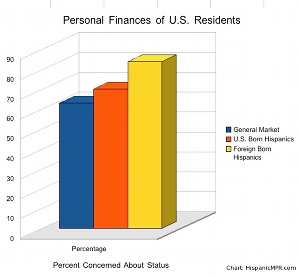
Personal Finances of U.S. Residents – click on image to enlarge 
As a result of the economic recession, Latinos may be adjusting their habits and behaviors including spending less on dining out and holiday shopping, and helping family members or friends with a loan. About 3 percent of Latinos received a foreclosure notification in the last year and 10 percent of Latinos missed a mortgage payment or were unable to make a complete payment according to a recent survey of 1,540 Hispanic adults by the Pew Hispanic Center.
Sixty-two percent of respondent homeowners said there have been foreclosures in their neighborhood over the same time period; and just over one third of those survey (36 percent) said they worry about their own home going into foreclosure. The number of foreign-born Latino homeowners worried about losing their home to foreclosure was much higher, 53 percent.
Respondents also indicated they sent less money abroad to their family in the last year. Just over 70 percent of Hispanic immigrants said they sent less money to relatives last year than in 2007.
At the same time survey respondents expressed greater concern about finances than the general population in the United States. Three quarters of U.S.-born Latinos surveyed and 84 percent of foreign-born Latinos, indicated their personal finances were in either fair or poor shape at the time of the survey, compared with 63 percent of the general U.S. population who expressed similar concerns.
The results of the survey were released in a report written by Mark Hugo Lopez, associate director, Gretchen Livingston, senior researcher, and
Rakesh Kochhar, associate director for Research, Pew Hispanic Center. The Pew Hispanic Center, a nonpartisan research organization, is dedicated to improving public understanding of the Hispanic population in the United States and to chronicle Latinos’ growing impact on the nation. It does not take positions on policy issues.
Target Latinos effectively by anticipating changes in the market with
“Hispanic Projections with 2007-08 update” audio recording

Presenter Roger Selbert, Ph.D.
Find out
- About Latino buying power growth in the future
- How Latino market growth compares with other markets in the U.S.
- What drives the rise of Latino economic clout
- Who should target the Latino market
- What is the size of the Hispanic affluent market
- If the luxury Latino market is growing
Stay ahead of your competition with “Hispanic Projections”
Posted by Elena del Valle on January 19, 2009
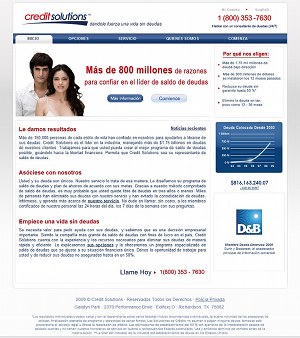
Click on image to enlarge
Photos: Credit Solutions
According to “A Snapshot of the Subprime Market” published in 2007 by the Center for Responsible Lending, 40 percent of subprime loans nationwide in 2006 were issued to Latino households. At the same time, information from September 2008 from the National Association of Hispanic Real Estate Professionals, “A Warm Welcome: Despite barriers, Hispanic home ownership may be the fix for national housing crisis Carolina del Norte,” indicates that by 2012 40 percent of first-time home buyers nationwide may be Hispanic.
Keeping this in mind Credit Solutions, a Texas debt management company, recently launched a Spanish language version of its website to reach Spanish speaking Latinos in the United States. Except for the text of the sample Settlement Letters and the Success Stories audio all the content on the main website was adapted for the Spanish language pages.
“It goes back to the original reason I founded Credit Solutions: to give families suffering real hardships, like job loss, medical bills, or a death in the family, an alternative to bankruptcy and a chance to have someone on their side, working for them. Lots of people don’t realize that most credit counseling agencies actually represent the creditors. We represent the consumer and act a mediator between our clients and their creditors,” said Doug Van Arsdale, chief executive officer, Credit Solutions in response to the question of why the company decided to target Latinos at this time.

Doug Van Arsdale, CEO, Credit Solutions
Executives at Dallas-based Credit Solutions believe Hispanic families have been particularly hard-hit by the economic situation and a disproportionate number is struggling against foreclosure. This may not come as a surprise to lending industry professionals.
According to the 2006 Hispanic Homeowner Seminar at the U.S. Department of Housing and Urban Development, non-white Hispanic Americans were 39 percent less likely to own a home at that time. Seminar representatives concluded that Latino homeowners maintain higher total amounts of debt and are more likely to be victims of predatory lending practices.
Often lenders justify higher mortgage rates for minorities claiming the individuals from these cultural groups have shaky credit histories, making lending to them riskier than to mainstream borrowers. However, in 2006, representatives of the Center for Responsible Lending examined 50,000 subprime loans (described as the “most extensive study of its kind”) and determined African-Americans and Latinos were almost a third more likely to end up with a high-priced loan than non Hispanic white borrowers with comparable credit credentials.
According to Credit Solutions promotional materials, its Spanish-language site offers advice, tips and tools designed to empower clients to achieve a debt-free lifestyle. There is an overview of why company representatives believe debt settlement is preferable to a debt consolidation loan, credit counseling or declaring bankruptcy. There are also videos of client testimonials; and settlement letters from lending sources detailing instances of settled accounts, and the actual savings in each case.
Credit Solutions is a privately held, for-profit firm founded by Van Arsdale in 2003. The company has three offices in Dallas, Texas and offices in Tempe, Arizona and Costa Rica.The company employs 920 individuals of which 20 percent are Hispanic. About 10 percent of Credit Solutions staff leadership is Hispanic.
According to online sources, including ConsumerAffairs.com, CreditInfoCenter.com, and WBZTV.com, there have been many complaints against Credit Solutions and at least one class action lawsuit against Credit Solutions of America.
“Since I am not familiar with these complaints, I have referred them to our Executive Review Team so that they are addressed immediately and resolved. We have 90,000 active clients, and we are 100 percent committed to customer satisfaction. If, for any reason, these complaints have not yet been addressed, they soon will be resolved to the best of our ability,” a Credit Solutions representative said by email when invited to respond to the issue.
Make your ads resonate with Hispanics
Listen to C&R’s Research Director Liria Barbosa in
“Hispanics’ Perspective on Advertising” audio recording

Liria Barbosa gives a presentation and participates in an extended Q&A discussion about
• Type of ads Latinos prefer
• Latino top media choices
• Percent of Latinos who tried products because of ads
• Percent of Latinos who purchased products because of ads
• What makes an ad “Hispanic”
• If ad language is important for bicultural Latinos
• What to keep in mind when targeting bicultural Latinos with ads
Click here for information on Hispanic Perspectives on Advertising
Posted by Elena del Valle on January 14, 2009
By Aldo Quevedo,
President, Dieste, Inc.

Aldo Quevedo, president, Dieste Dallas
Photo: Dieste
When the fit is right, a Hispanic agency can help brands grow their relationships with multicultural consumers for meaningful, powerful interactions that make sense and connect with consumers’ lives. But the wrong choice can put your efforts in question, since this savvy demographic is always on the watch for commitment and for brands that really speak and interact with them.
Click here to read the complete article
Hispanic Marketing and Public Relations Understanding and Targeting America’s Largest Minority book

“A must resource for practitioners/professionals expecting to reach US Hispanics; also valuable for college programs in marketing, public relations and communications. Highly recommended.”
Choice magazine
Click here for information on the Hispanic Marketing & Public Relations book
Posted by Elena del Valle on December 18, 2008
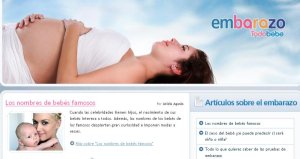
Embarazo.com hompage – click on image to enlarge
Parenting publisher Todobebé, Inc recently re-launched embarazo.com, a website dedicated to Spanish dominant pregnant women. Embarazo is Spanish for pregnancy. Although Todobebé first acquired the URL in 1999, executives at the company believe now is the right time to target this market segment. The website is designed to provide original content about pregnancy related issues to Spanish speaking families.
The website features articles about pregnancy, links to information, tools, community, and resources on everything from planning a pregnancy to being a parent.
According to a Todobebé press release there are over 10 million births globally born to Spanish speaking families, and millions of searches for pregnancy information on the Internet each month.
Todobebé reaches United States Spanish speaking Latino parents with books, television programs, radio, events and online. Todobebé focuses on families planning, expecting and raising babies through varied media platforms.
Discover from a new mom market expert how to reach Latino moms by listening to
“Marketing to New Hispanic Moms – a case study” audio recording

Presenter Cynthia Nelson, COO, Todobebe
Find out about
• New Latina mom market
• Baby demographics including market size, profile
• New moms’ language preferences
• Latino baby market trends
• Factors influencing Hispanic baby market
• Location of new Hispanic moms’ market
• Issues affecting new Latino moms
• Todobebe strategies
Click for information on “Marketing to New Hispanic Moms – a case study”
Posted by Elena del Valle on December 9, 2008

Andria Macias-Castillo, executive director, ¡Adelante!
Photo: ¡Adelante!
Miller Lite will donate $40,000 for scholarships to the ¡Adelante! U.S. Education Leadership Fund in Texas. The donation will provide scholarships for Hispanic students 21 and older pursuing a secondary education.
“Latino college students have great potential to be successful in every aspect of their lives, but reaching that success can be challenging,” said Andria Macias-Castillo, executive director of ¡Adelante! “Miller Lite and ¡Adelante! are investing in our youth to develop Latino leaders for the future.”
Through the end of the year, participating Texas retailers will feature Miller Lite point-of-sale (POS) materials to create awareness of the Adelante! scholarships. The POS materials include a tear away form with information on how to apply for the ¡Adelante! scholarships.
According to Marcela Fajardo, MillerCoors trade marketing manager, SW Region, Miller Lite is a founding partner of ¡Adelante! and has contributed more than $2.2 million to support educational programming and scholarships since its inception in 1993. As part of the program, Miller Lite is reaching out to the Texas Latino community through local retailers to generate interest in the ¡Adelante! program.
“Miller Lite is committed to supporting the educational and leadership needs of the Hispanic community and ¡Adelante! partners with us by helping to prepare the next generation of Hispanic leaders,” said Fajardo.
Scholarship applications and criteria will be available on-line through the ¡Adelante! website, adelantefund.org. Full-time, undergraduate students 21 years of age and older with a minimum 3.0 grade point average are eligible to apply. The scholarship amounts will range from $1,000 to $1,500.
Hispanic Marketing and Public Relations Understanding and Targeting America’s Largest Minority book

“A must resource for practitioners/professionals expecting to reach US Hispanics; also valuable for college programs in marketing, public relations and communications. Highly recommended.”
Choice magazine
Click here for information on the Hispanic Marketing & Public Relations book
The ¡Adelante! mission is “To inspire the best and brightest Latino college students to graduate and succeed through scholarships, internships and leadership development.” Every year, ¡Adelante!, based in San Antonio, Texas, provides 100 scholarships to Latino students across the country.
Since the inception of the program in 1993, all of the Miller funds were designated for scholarships, internships and leadership workshops. Miller was a founding sponsor of Adelante as part of its support of the Hispanic Association of Colleges and Universities (HACU).In 1999, ¡Adelante! became a non-profit 501C3.
Antonio R. Flores, Ph.D., president, Hispanic Association of Colleges and Universities in San Antonio, Texas chairs the ¡Adelante! board of directors. Other board members include: Louis Agnese, Ph.D., president, University of the Incarnate Word in San Antonio, Texas; José R. Ruano, manager, Multicultural Relations, Miller Brewing Company in Milwaukee, Wisconsin; Ron Acosta, secretary, Texas multicultural public relations manager, Texas Market Area – Miller Brewing Company in Dallas, Texas; Heriberto “Berto” Guerra, Jr., chief executive officer, Avanzar Interior Systems in San Antonio, Texas; Robert Ayala, manager, Strategic Communications, Dell Computers in Austin, Texas; and Beatriz Robinson, Ph.D., vice president, Planning and Enrollment, St. Thomas University in Miami, Florida.
According to promotional materials, Miller Lite’s parent company, MillerCoors, is the second largest beer company in America, capturing nearly 30 percent of U.S. beer sales. MillerCoors, a privately held company, is a joint venture of SABMiller plc and Molson Coors Brewing Company.
Although a company representative declined to share Hispanic market numbers, she indicated that “like most consumer product companies, the Hispanic market is a growing and important one for MillerCoors.” In relation to the number of Hispanic employees and board members at MillerCoors, the company representative indicated that “Employee numbers are proprietary, but creating a diverse workforce reflective of the market is a priority for MillerCoors.”
Target Latinos effectively by understanding how they shop
“Hispanic Holiday Shopping Patterns” audio recording

Manuel Delgado, CEO Agua Marketing, gives a presentation and participates in an extended Q&A discussion about
- Hispanic shopping patterns national survey
- Why Latino consumers may be more desirable than general market shoppers
- Hispanics holiday shopping patterns and behaviors
Click here for information on “Hispanic Holiday Shopping Patterns” audio recording
Posted by Elena del Valle on December 8, 2008

Reinaldo Padua, assistant vice president, Coca-Cola North America
Photo: Coca-Cola North America
A podcast interview with Reinaldo Padua, assistant vice president, Hispanic Marketing, Coca-Cola North America is available in the Podcast Section of Hispanic Marketing & Public Relations, HispanicMPR.com. During the podcast, Reinaldo discusses effective marketing to Latinos and his company’s efforts to target United States Latinos with Elena del Valle, host of the HispanicMPR.com podcast.
He is responsible for leading the Hispanic marketing strategy and program execution for Coca-Cola North America. Reinaldo joined The Coca-Cola Company in his current capacity in January 2008.
Reinaldo started his marketing career at Procter & Gamble in marketing research. He has more than 12 years of experience in multicultural marketing, general marketing strategy, product management and market research in global consumer package goods and telecommunications.
Prior to joining Coca-Cola, he was a managing consultant for Wendy’s International, The Coca-Cola Company, and ConAgra Foods at Zyman Group. Prior to joining Zyman Group, he was senior marketing manager with BellSouth Corporation Internet Access Products. Before BellSouth, he was a category brand manager with Kraft Foods in Venezuela.
Born and raised in Venezuela, Reinaldo received an MBA degree from Duke University and bachelors degrees in Systems Engineering and Business Administration from the Universidad Metropolitana, where he was Class Valedictorian in 1994. He resides in Atlanta, Georgia.
To listen to the interview, scroll down until you see “Podcast” on the right hand side, then select “HMPR Reinaldo Padua,” click on the play button below or download the MP3 file to your iPod or MP3 player to listen on the go, in your car or at home. To download it, click on the arrow of the recording you wish to copy and save it to disk. The podcast will remain listed in the December 2008 section of the podcast archive.
Target Latinos effectively by understanding how they shop
“Hispanic Holiday Shopping Patterns” audio recording

Manuel Delgado, CEO Agua Marketing, gives a presentation and participates in an extended Q&A discussion about
- Hispanic shopping patterns national survey
- Why Latino consumers may be more desirable than general market shoppers
- Hispanics holiday shopping patterns and behaviors
Click here for information on “Hispanic Holiday Shopping Patterns” audio recording
Posted by Elena del Valle on December 2, 2008
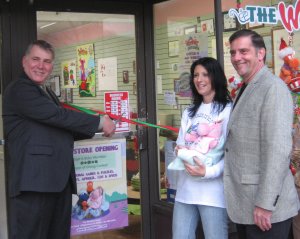
Cutting the ribbon is Keith Killion, deputy mayor, Ridgewood, New Jersey, Laura Wellington, creator, The Wumblers and Doug Seiferling, president, Ridgewood Chamber of Commerce
Photos: Giddy Gander Company
On November 14, The Wumbler Patch, the first Wumblers retail store, opened its doors to the public in Ridgewood, New Jersey. Now fans of the cartoon program for children will be able to shop for the complete line of Wumbler product including plush, games, puzzles, DVDs, CDs, and apparel at the store. The new shop carries merchandise, made in China and the United States, for children three and older priced between $3 and $9.
The new store, designed to resemble a watermelon patch (in the cartoon program baby Wumblers are born from watermelon), marks the beginning of the roll out of Wumbler merchandise within larger retail stores across the country.
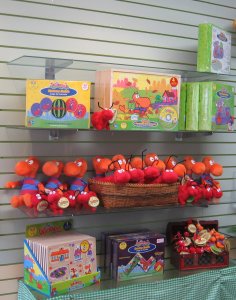
“Nothing like this has ever been done before,” said Laura J. Wellington, creator and chief executive officer, The Wumblers children’s brand. “But, now more than ever, we need to teach our children a better way. The Wumbler Patch is a means of doing so. It provides a fun place for children (and parents) to go in which to share an experience that positively impacts their community. This store goes beyond just selling merchandise. The store concept is very innovative and remains consistent with the grassroots emergence and initiative that founded the entire Wumbler brand. Positive change means getting at ‘the roots.’ Those ‘roots’ are our children!”
The Wumbler Patch, a television cartoon series, was developed to help teach children how to make the world a better place to live and grow. The Wumbler Patch store was designed to reinforce this original goal while offering a fun and engaging environment for children and their parents to shop.
The Wumblers is a television cartoon series.The Wumblers, multi-colored, bulbous-shaped characters, are the creation of Wellington, a preschool teacher, who also co-founded the Giddy Gander Company LLC.
Find out what multicultural kids across America think
Listen to Michele Valdovinos, SVP, Phoenix Multicultural in
“Marketing to Multicultural Kids” audio recording

Michele Valdovinos gives a presentation and participates in an extended Q&A discussion about multicultural children based on a Phoenix Multicultural and Nickelodeon study of 1,300 multicultural children in 16 United States markets.
Find out about
• The Phoenix Multicultural Kids Study
• Relationship between children and their context
• Issues relating to family, technology and media, diversity, buying power, relationships in household, self perception, values, acculturation, cultural heritage, frequency of media activity, income and spending, brand preferences, the American Dream
• How many billions of dollars buying power multicultural kids children have
• Children’s spending attitudes, habits by ethnicity
• How much money a year Hispanic kids have available to spend
• Types of products Hispanic kids buy
Click here for information on “Marketing to Multicultural Kids” audio recording
Posted by Elena del Valle on December 1, 2008

Aldo Quevedo, president, Dieste Dallas
Photo: Dieste
A podcast interview with Aldo Quevedo, president, Dieste Dallas is available in the Podcast Section of Hispanic Marketing & Public Relations, HispanicMPR.com. During the podcast, Aldo discusses reinventing the Hispanic agency with Elena del Valle, host of the HispanicMPR.com podcast.
Aldo began his creative career in advertising in 1990 as a copywriter with Ogilvy & Mather Mexico. Starting in 1996, Aldo has helped establish Dieste as one of the leading agencies in the Hispanic market.
Several national and international award committees have recognized his work. He was the first Mexican to win a Cannes Lion and the Grand Award at the New York Festivals.
His work has received several Best of Show at the ADDY Awards, two Best of Show Awards at the Advertising Age Hispanic Awards, and several SOLES at the Festival Iberoamericano de Agencias de Publicidad in Buenos Aires, Argentina.
In 1999, 2000 and again in 2002, LatinSpots, an advertising industry magazine in Latin America, chose him as the top Hispanic Creative Director in the USA. In 2004, Aldo was inducted into the Hall of Achievement of the American Advertising Federation (AAF).
To listen to the interview, scroll down until you see “Podcast” on the right hand side, then select “HMPR Aldo Quevedo,” click on the play button below or download the MP3 file to your iPod or MP3 player to listen on the go, in your car or at home. To download it, click on the arrow of the recording you wish to copy and save it to disk. The podcast will remain listed in the December 2008 section of the podcast archive.
Target Latinos effectively by understanding how they shop
“Hispanic Holiday Shopping Patterns” audio recording

Manuel Delgado, CEO Agua Marketing, gives a presentation and participates in an extended Q&A discussion about
- Hispanic shopping patterns national survey
- Why Latino consumers may be more desirable than general market shoppers
- Hispanics holiday shopping patterns and behaviors
Click here for information on “Hispanic Holiday Shopping Patterns” audio recording
Posted by Elena del Valle on November 19, 2008

Bob Liodice, president and CEO, ANA
Photos: Association of National Advertisers (ANA)
Yesterday, the Association of National Advertisers (ANA) has announced the winners of the 2008 Multicultural Excellence Awards during the 10th annual ANA Multicultural Marketing Conference in Boca Raton, Florida. In its eighth year, the awards recognize ANA member companies and marketers in six categories for their work in producing multicultural advertising campaigns that aired between June 2007 and May 2008.
This year, the ANA created a new category for strong work across all ethnic segments in Digital Media. The winners in each category were: Blue Shield of California won the Hispanic ad category for the Blue Shield of California ad. In the African American category, Prime Access, Inc. was recognized for the Partnership For a Drug Free America ad; and in the Asian category interTrend Communications won for its State Farm Insurance ad.
Make your ads resonate with Hispanics
Listen to C&R’s Research Director Liria Barbosa in
“Hispanics’ Perspective on Advertising” audio recording

Liria Barbosa gives a presentation and participates in an extended Q&A discussion about
• Type of ads Latinos prefer
• Latino top media choices
• Percent of Latinos who tried products because of ads
• Percent of Latinos who purchased products because of ads
• What makes an ad “Hispanic”
• If ad language is important for bicultural Latinos
• What to keep in mind when targeting bicultural Latinos with ads
Click here for information on Hispanic Perspectives on Advertising
The Vidal Partnership received the recognition for Digital Media for the Cadbury Dentyne ad; DDB won in the General Market Category for its McDonald’s ad; and Grupo Gallegos won in the Campaign with Significant Results category for its Energizer ad.
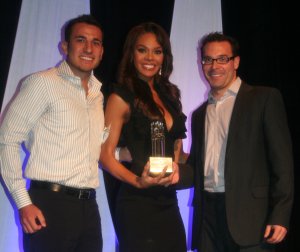
Hispanic category winners: Juan Zubiate, Latino project manager and Seth Berman, director of Marketing Stratey and Operations, Blue Shield of California and Miss USA, Crystale Stewart
“Our winners have established themselves as leaders in the world of multicultural marketing and their work represents the best in our industry,” said Bob Liodice, president and chief executive officer of the ANA. “I am thrilled that through the Multicultural Excellence Awards, the ANA is able to recognize the contributions these organizations have made and the growing importance of speaking to consumer through multicultural channels. I offer all of them my congratulations.”
The awards are sponsored by the ANA Multicultural Marketing Committee. The winners, selected by members of the 134-member committee, were judged on a scale of one to ten (where 20 was a perfect score) for creativity and relevancy to multicultural markets. Established in 1998, the committee is dedicated to helping ANA members share knowledge and best practices in marketing to America’s ethnic markets.
A portion of the proceeds collected from the awards submission fees is earmarked to help fund scholarships for multicultural students pursuing careers in advertising and or marketing.
The ANA’s mission is to “provide indispensable leadership that drives marketing communications, media and brand management excellence and champions, promotes and defends industry interests.” The ANA is a source of marketing communications best practices information. Tasked with leading industry initiatives, influencing industry practices, managing industry affairs, and advances, promoting and protecting advertisers and marketers; the trade association represents 400 companies with 8,000 brands that collectively represent $250 billion in marketing spending.





























